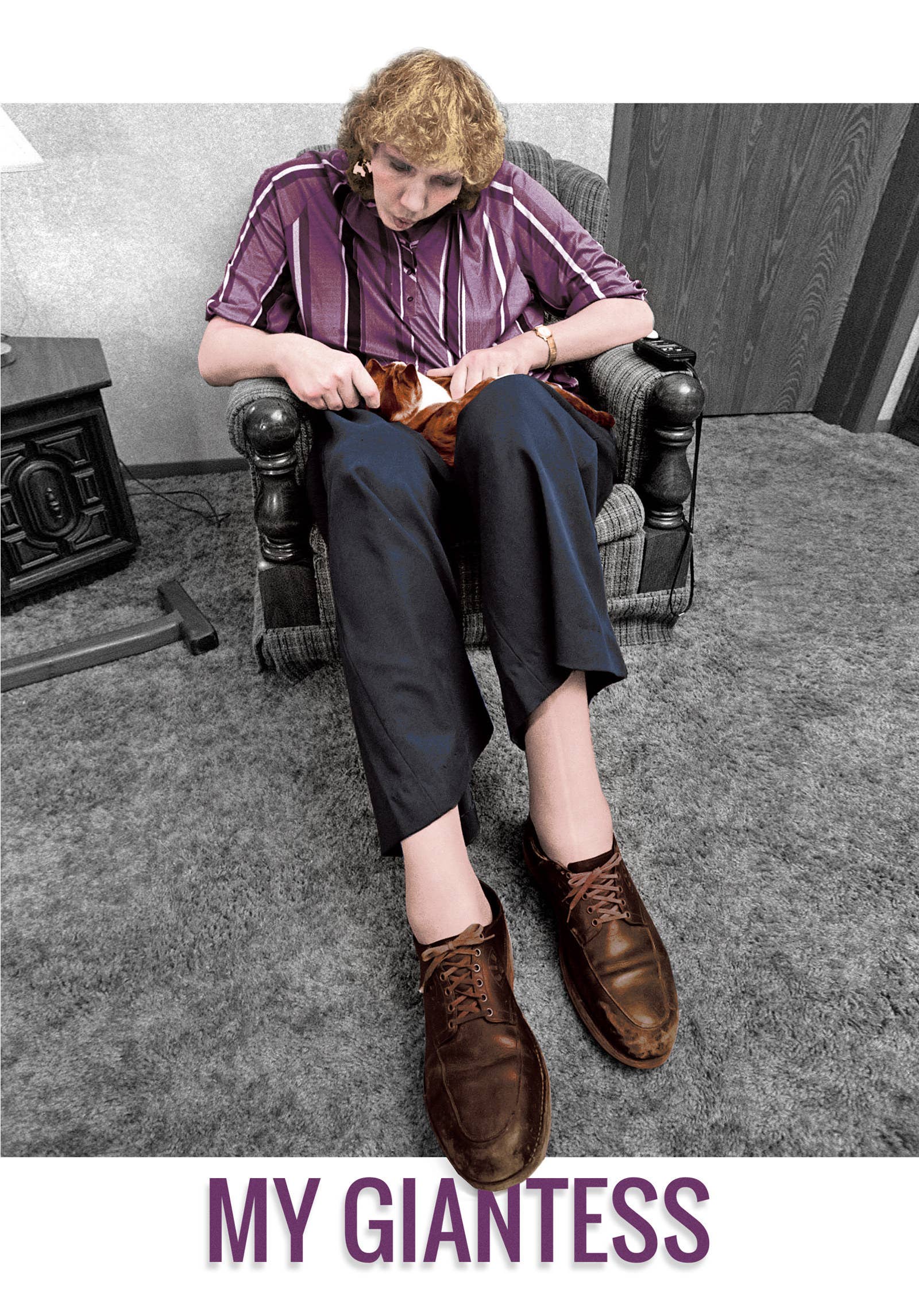
"For his giant work, he even imported a giantess from America," one news article about the picture had read, a find that had ended director Federico Fellini's, "worldwide search for an amazon."
She was credited: "Sandra E. Allen – Giantess."
In the film, Casanova, played by Donald Sutherland, first meets the Giantess in a chaotic pub, where she is humiliating men one by one at arm wrestling. A loud thud, and cheers, a loud thud. She is made even more enormous-seeming by the camera’s low angle and the large veil she wears.
He finally approaches, and asks, “Who are you, mythological creature?” Sandy's replies are not her own voice; Fellini dubbed his film in Italian. The woman who voiced Sandy sounded particularly effeminate; Sandy's real voice was deeper, mannish.
Intrigued, Casanova follows Sandy to her room, where she is bathed in a large wooden tub by two dwarfs. One catches our voyeur and with a wink, continues to let him watch. The audience never sees anything but Sandy’s milky back.
Sandy was a modest girl, a churchgoer. In the darkened theater she grew more and more nervous and eventually rose, and left, though probably not without being noticed. At a little over 7'5", Sandy held the Guinness World Record for being the tallest woman alive, a title she'd received about two years prior. (She was still growing; her eventual record-holding height would be 7'7¼".) On one hand, the title meant she would live a life much more glamorous than those of the other residents of Shelbyville — this premiere was evidence of that. On the other, it meant the divide that existed between her and all other people would only continue to grow.
I was a college freshman when a guy remarked that I had the same name as the title of a pop song by the New Zealand band Split Enz called "Hello Sandy Allen." For a strange second I thought someone had written a song about me, but then I googled the title, and caught my first glimpse of its subject. It's a weird moment when you realize you have the exact same name — first, last, middle initial — as the tallest woman alive. I gawked at her.
Likewise, Split Enz frontman Neil Finn gawked when he met Sandy backstage at a talk show in 1976. "Hello Sandy Allen / the world's tallest woman" Finn's lyric begins. He goes on to say he felt "uneasy" when he first laid eyes on her and the enormity of the handshake. That sense quickly abated when he saw how optimistic she seemed. "Appearance never held you back," he goes on in the chorus, "Must be when you're number one / You don't have to try so hard."
Though on occasion I'd mention in passing that I shared a name with the tallest woman alive, I didn't actually think of Sandy often — until 2008. I saw in the New York Times that she had died and I read about the years she spent in a nursing home even though she was only 53. I read how rare gigantism is, and how it ensured poor health and physical pain on top of the constant ridicule and anguish. The deeper I dug, the more I realized how much more there was to consider than a coincidence of names — and the more I realized how wrong Neil Finn turned out to be.

Sandy Allen was born an average-sized baby. This is how all biographies of her begin. Her mother lived up in Chicago and had problems, drank, and brought Sandy home to Shelbyville soon after she was born, where she was raised by her grandmother, Emma Warfield. Her father was rumored to be a truck driver. "Allen" was the name her mother wrote on Sandy's birth certificate, Sandy's longtime friend Rita Rose explains to me, adding she doesn't know if her mother didn't just make it up.
Their house was small and its paint peeling. Indoor plumbing had come only years before and didn't always work. Warfield, whom Sandy called "Ma," worked as a housekeeper and was, in Rose's words, "a total sweetheart." Sandy's mother was not. She moved in when Sandy was in junior high, bringing along one of Sandy's several half-siblings, a boy named Michael. As Rose describes it, Sandy's mother was emotionally abusive, especially toward the boy, and an embarrassment to Sandy; especially given that it was a small town, people talked. "She just caused this turmoil in the household," Rose says.
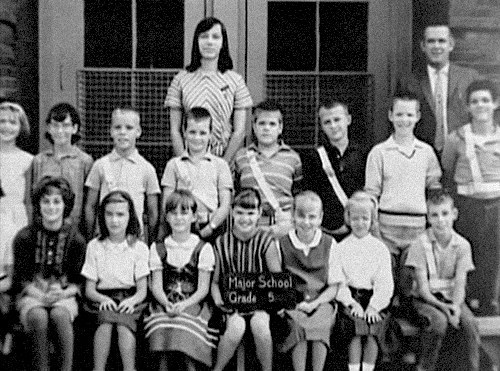
Her peers teased or ignored her. She had few friends. She was tall enough that they saw her only as tall, and then as someone not worth seeing. Coaches at her high school momentarily thought she might be useful on the basketball team but she wasn’t really athletic. Her leg bones had grown so quickly, in fact, she needed surgeries, two of them, just to walk, which she then did with a limp.
After graduation she worked as a secretary at an oil company, then at the Indianapolis Bureau of Motor Vehicles, in the abandoned vehicles division. Her third job was as a secretary again, this time in the state veterinary office. It was there, in 1974, that some co-workers, prodding to know how tall she really was, kicked off their pumps and climbed on desks and chairs and dangled a tape measure down. They sent the figure to Guinness, in London, which replied that she was taller than any woman they had on record but the measurement needed to be verified by a medical professional. Sandy got in her car — which was hard-earned, and into which she barely fit — and drove to her family physician, where the figure was confirmed. Her name and picture were printed in the 1976 edition of the book.
In an interview with local news soon after its publication, Sandy seems genuinely excited. She wears a teal dress and hangs her white shawl as she enters her office. Her dark hair is boy-short. Though she is extremely tall, she seems almost childish.
“Are you sensitive about your height or do you enjoy it?” the reporter asks up at her.
“When I was a freshman in high school I used to get a lot of comments about my height, especially from the boys, and that really upset me,” Sandy replies, her square glasses shining. “But now that I’ve gotten to be the World’s Tallest Woman I’m going to take advantage of all the publicity I can get. I’m really enjoying it now. That’s why I feel like if I grow a few more inches, what the heck.”
Sandy was asked up to Minneapolis to do a Marriott opening and flew on an airplane for the first time out to Los Angeles, to be interviewed on The David Frost Show. Soon after an agent contacted her about the Fellini film. She’d never heard of the director before, but Sutherland she had. The state veterinary office wasn’t about to let her leave for the several weeks of shooting until the governor intervened and off Sandy went to Italy.
Imagine her: a 19-year-old Christian girl of little means in home-sewn enormous clothes, who’d barely left Indiana, let alone America, as she stepped off that plane in Rome. Heads swiveled; bulbs flashed. Sandy, who’d been told by her boss that Italian men liked to pinch “rear ends,” walked through the terminal with her purse behind her. Filming took time; Fellini asked Sandy to stay six weeks rather than the original three. She toured the countryside with the director and his wife, had her first glass of wine, saw Bianca Jagger on set, stayed in Roman Polanski’s mansion, which Sutherland had rented. Fellini and his wife were kind enough to get a limousine for her so she could tour the Vatican, and there, on the cobblestones, soldiers and tourists swarmed her. She was, in some sense, more holy a sight.
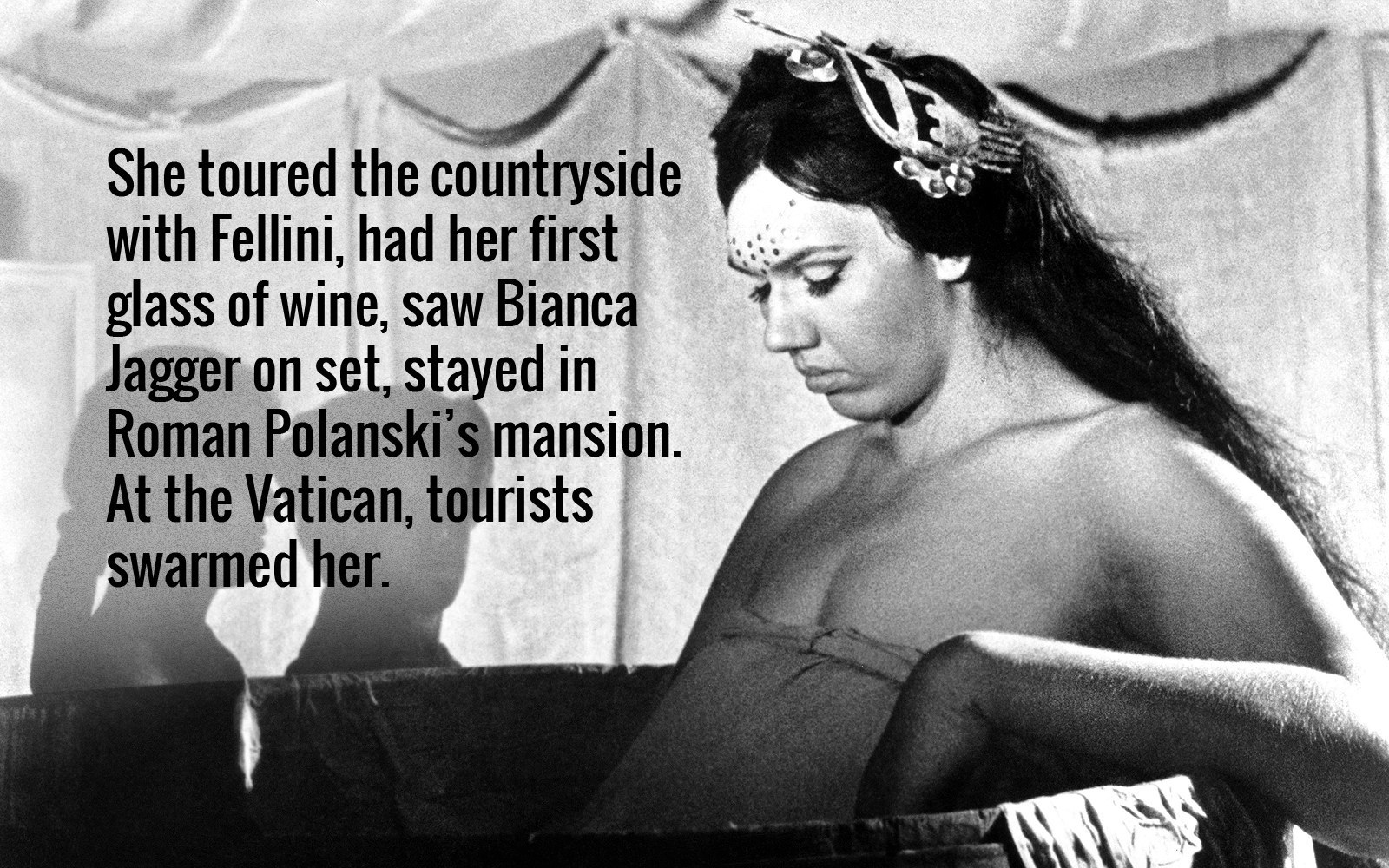
After she returned from Europe she finally went to an endocrinologist. She was in her early twenties and hadn't ceased growing. It was now that she finally heard the word "acromegaly."
Acromegaly is a rare condition caused by an excess of growth hormone, often because of a tumor on the pituitary gland. Gigantism is an ever more rare prepuberty onset of the condition. Because patients with acromegaly are adults, meaning they've finished growing, they do not grow taller, but they do get thicker. Their teeth space apart, their hands balloon. Dr. Laurence Katznelson, professor of neurosurgery and of medicine at Stanford University, explains to me what acromegaly “looks like” by mentioning Richard Kiel, who played Jaws in The Spy Who Loved Me and Moonraker. His disease, in other words, made him a villain. (“You really have the same name as the person we will discuss?” Katznelson had asked at the beginning of our call.)
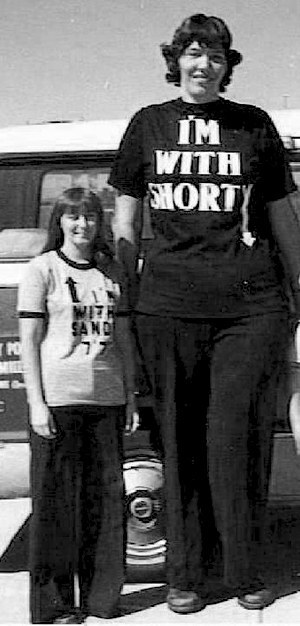
Rita Rose says Sandy had been taken to a specialist as a pre-teen, who explained that she needed brain surgery, but as her family was uninsured, they simply didn't return. Now doctors told her that the tumor, which was near her optic nerve, would eventually cause her to go blind. The surgery capped the then-20-year-old's height at the record 7'7¼".
"She had to wear a wig for a year," Rose recalls. Her long friendship with Sandy began around that time; they'd first met when Rose interviewed her for a story she was writing for the Indianapolis Star. Rose laments the fact that Sandy's grandmother and mother didn't just agree to the surgery initially. "If she had the surgery at that time, then she would have been a tall person but a normal tall person."
Gigantism does not affect height only. "It affects all organs," Katznelson explains. "It affects the heart. It can affect pancreatic function. Patients often have diabetes. Thyroid can be enlarged so they have goiters.” He lists other what he terms “co-morbidity” factors, including joint problems, sleep apnea, other hormonal deficiencies, depression. Men have low testosterone; women don't menstruate (according to Rose, Sandy never did). He summarizes, “All acromegaly, including gigantism, begets premature mortality.”
Sandy’s doctors told her she shouldn’t expect to see her 30th birthday.
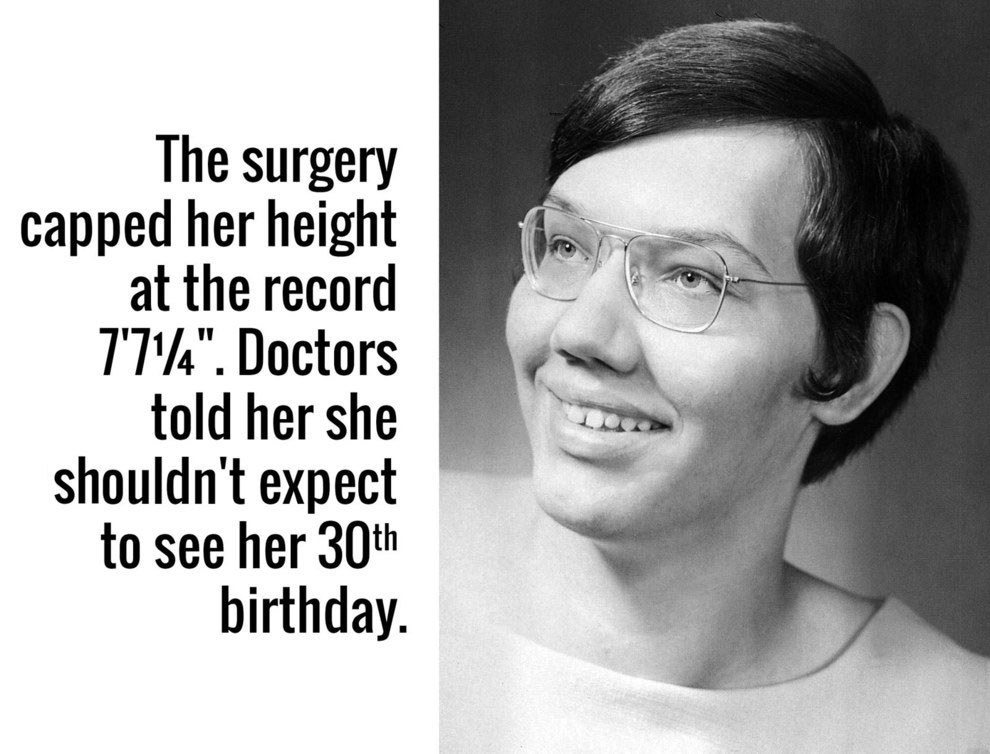
Sandy would always have two options: a life lived publicly — one that embraced her title, perhaps attempted to do good with it, but invited judgment — or a private one. Soon after she became aware of how short her life might be, she elected the former. A Scottish promoter named Norman Adie first took Sandy to Australia, where she appeared at several department stores. That summer she did appearances at Adie’s Fantastic Facts and Feats in Wildwood, N.J. Sandy brought along Michael and adopted a dog she called Adie. After two summers there, she decided to take a job at the Guinness Museum in Niagara Falls, Canada.
"At that point her family needed money, and she wasn't making it too well on a secretary salary," Rose says. "She could be out on her own and make it for herself. That appealed to her."
The 1981 Canadian documentary Being Different shows how Sandy spent her eight years at the museum. She is announced and comes out from behind a curtain. She wears blue eye shadow and pink slacks. Seated, she is still tall. She holds a Superscope microphone into which she begins her very rehearsed-sounding spiel: “Good afternoon, all you short people. How you doing today? My name is Sandy Allen and I’m the tallest living woman in the world.” It’s peppered with tame jokes, many of which she’d repeat throughout her life, in interview after interview. She asks short guys to “eat their hearts out.” She recites her 450-pound weight, “give or take an ounce.” She then opens it up for questions. “Don’t hesitate,” she commands after a pause. “I’ve been asked everything from ‘How is your sex life?’ to ‘How big is your toothbrush?’” The room chortles. One woman asks if she has kids. She replies she doesn’t; Michael is the boy who’s entered alongside her. A man asks whether she eats more than average. “Well, for breakfast this morning I only had three short people, so that’s not too much,” she answers, a little too breezily.
“Her shoe size is 22,” the male narrator says as footage rolls of Sandy’s petite grandmother helping her into a jacket. “All her clothes must be custom-made.” The narrator adds that she’s made a choice to be “on exhibition.”
“Well, my height is there, why not take advantage of it?” Sandy asks. “I’m proud of my size. I’m not running away from it. I’m doing this in order to show people that I can handle the problems that were presented to me by my size; now, why can’t you handle yours?” And in some respects, it seems this was a proud time for her. She made a decent living, had her own apartment, met a lot of people, doing something relatively easy. The curtain. The spiel. Repetitive questions. Invasive questions. Insulting questions. Stooping for photos. Children with sticky hands. Indifference. Laughter. A dozen or shows a day, eight hours a day, five days a week, for eight years. But the tourists who came — did they really come to have their hearts and minds changed? (Are my motives for investigating Sandy any more pure?)
"Basically it was a freak show," Rose says.
During her years with Guinness, Sandy traveled to Puerto Rico, Venezuela, Japan twice, and Thailand, where she visited an alligator farm and was kissed by an orangutan. During her second Japan trip, the media found it funny to sew her an extra-large bridal gown and stage a fake wedding between her and her choice of the world’s two largest living men. Though it was just for show — both men were married — they spared no expense. They kept the dress but would send it if she ever requested. She never did. By many accounts she never had a serious relationship. By many accounts she would have been an incredible mom.
Sandy eventually could take it no more, and returned to Indiana. She became a secretary in the office of Indianapolis’ Mayor William Hudnut, a job she enjoyed. They outfitted her with an extra-large desk, an extra-large chair. She could type 90 words per minute despite her fingers. Once the Indianapolis Indians visited and had more fun talking with her than they did with the mayor. (She was a big fan of them, and also of the Pacers, who helped her buy shoes.) After, she worked briefly at a sewage treatment plant. By this point her health and mobility were declining and she elected to go on government medical aid. The poverty she’d known as a child would stalk her until her end.
A man named John Kleiman, who’d formerly managed fellow Indianan Bobby Helms, most famous for his rendition of “Jingle Bell Rock,” approached Sandy at a parade and asked to be her manager, to which she agreed. In the late '70s and '80s, she'd had scattered talk show appearances, including Oprah.
With his help, she appeared on more shows, including Jerry Springer, whose host dropped his usual sensational antics while she and other Guinness holders appeared. She appeared on Vicki Lawrence alongside the man who could smoke the most cigarettes at once. She was on Montel alongside the world's shortest twins and a man with a bone in his nose. She did Leeza Gibbons alongside the man with the world’s longest mustache, the man with the world’s best memory, the woman who had lost the most weight, the woman who was the most flexible, and an escape artist, who escaped on the show from a washing machine. In the mid-'90s, she twice did Howard Stern.
“I have dwarfism of the genitalia,” Howard says, and asks whether her genitalia are normal or proportional.
“I believe everything is proportional,” Sandy replies, playing along. He gets her to say she can’t use regular-sized Tampax and that she’s still a virgin. “My moral standards are, I guess by today’s standards, a little old-fashioned,” she admits.
“You ever get horny for a man?” he asks.
“Of course I’d like male companionship,” Sandy answers with thought. When a caller who’s 6'3" calls in and asks her to have tall children with him, Sandy says she gets asked out all the time by less-than-desirable-seeming gentlemen. Howard’s parting advice to her is that she buy a Hitachi Magic Wand.
While Sandy felt Maury Povich was nice, the talk show host who was her favorite was Sally Jessy Raphael. The first show she did for her, “Don’t Stare, I’m Still Human,” featured a woman who had a severe skin disease, a baby who had a mole that covered a third of her body, a baby with a disease that made her pee smell like maple syrup, a man who ate uncontrollably, and a girl who had a disease that affected her muscles and her bones. Sandy enjoyed that such programs encouraged people to understand and sympathize with those who suffered from strange and unusual diseases — and the humiliation, the isolation, the pain therein. When Raphael more or less repeated the program with a different slate of guests, she let Sandy co-host, a first.
She did these appearances, and spoke at Tall Clubs — an organization for men taller than 6'4" and women taller than 5'10" — churches, and elementary schools. She did it not for the money (she couldn't make too much and lose her disability): She did it to spread the tolerance of difference.

She wouldn't have traveled had she not cared so much about her cause: Traveling was extremely difficult for her. As Kleiman explains to me, television producers often didn’t understand the need for a first-class bulkhead seat, the limo or suburban for transportation. If they were traveling for more than two days, she’d need a woman to help her dress and bathe in the hotel room sink. Sometimes a fire department needed to meet her on the tarmac to help hoist her off the plane. And then, of course, were the glares and sighs and stares from PAs, flight attendants, other travelers. Appearances also garnered negative attention in the press. She was slandered in tabloids all the time. This was before the internet or reality television, before social media might have connected Sandy more intimately with her fans, and before the rise of reality television devoted to capturing lives that are somehow different — for better and for worse.
"She couldn’t go anywhere without people recognizing her," Kleiman says. Since I've begun researching Sandy, I've been surprised at the number of people who do say they met her once, they saw her once, and where, and what she said to them. She was someone you do not forget. Once, during an appearance at a San Francisco museum, she was approached by a figure in dark sunglasses who revealed himself to be Michael Jackson. He told Sandy he was a fan of hers and mailed her an autographed record.
“In the hundred of times we were out in the public, I never saw her be nasty to anyone who came up to say hi to her,” Kleiman says. “She would be eating, and a crowd would gather around and she’d stop eating and sign autographs. “I have never known anyone with a heart like Sandy Allen.”

In addition to her knees, Sandy had lung troubles early on, and early-onset arthritis. The tumor returned and was again removed. Though her body required a lot of water, going to the bathroom was such a production that she often had urinary problems. She got a bad sinus infection, and a blood one. She had to watch out for falls, for ceiling fans and doorways, for not getting stuck in bathtubs. She walked all day long once at Disney World, and the resulting blister grew so bad she eventually had her big toe amputated, compromising her mobility. The older she grew, the harder it was for her system to recover. The longer she was made to stay in bed, the more bed-ridden she became. “She almost died three or four times,” Kleiman says. He credits God, and the fact that she stayed so active, trying to spread a positive message, for her ability to live so long.
“She was the longest-lived giantess in the history of the world!” he exclaims, and there’s something in this phrasing, the majesty of it, that I feel impressed to even be talking to a man who knew her well.
But Sandy was depressed. Kleiman seems disappointed to admit this, as if she would let down her fans if they realized that she wasn’t as positive as she outwardly seemed. Kleiman lived just a floor above her. Sometimes, he recalls, she stopped taking care of herself. Sometimes she physically hurt herself. She always hated hospitals, doctors. More than once she’d been brought to the hospital against her will, Kleiman tells me, which involved the need for five or six medical personnel, her legs dangling out an ambulance’s back door. He admits she was admitted to a psychiatric facility at least once as well.
He recalls the movie My Giant, one line in particular — “You’ve never seen an old giant, have you?” — and says that affected her greatly. “She would have much rather been normal and not have been noticed by anyone."
When she could no longer travel, he wrote a book about her called Cast a Giant Shadow, which he self-published in 2001. Half of it is written as her, in the first person; the other half he wrote as himself, giving an outside perspective. He says she didn’t mind this form, that she read what he’d written and approved it, changing, according to him, “about six words.” When I realize this, I’m bothered that the only testimony I would have thought was Sandy herself was instead someone speaking for her. Really, like everything, it’s just an impression of what the outside world thought of Sandy Allen.
As her health continued to fail, she went from nursing home to nursing home, eventually ending up in a Shelbyville facility where her grandmother had died some years before. It was also where, coincidentally, the then-World’s Oldest Woman, 115-year-old Edna Parker, lived. (It's said they were friendly.)
Sandy had a private room with a television and computer and a closet. "She had everything you could possibly want if you're going to live in one room," Rita Rose says. People would visit her some, but she was frustrated with her circumstances, once so much that she was even caught wheeling down the street, headed down to a local bar. "She just wanted a normal night out with her friends," Rose says, recalling visits in Sandy's room, bringing her cigarettes.
In 2008, Rose also penned a book about Sandy's life, a somewhat fictionalized one that focused on Sandy's younger years, called the World's Tallest Woman: The Giantess of Shelbyville High. Sandy had been very sick that summer, and though she'd long been an avid reader, she didn't much have the energy now. Rose drove down to Shelbyville, and picked up a couple of chocolate éclairs from a local bakery and some cartons of milk.
"I went to the nursing home and we sat there and ate and I read the entire manuscript to her. It took, like, four and a half hours. I wanted her approval," Rose says, which Sandy apparently gave. "Then two weeks later she died." It was early in the morning, Aug. 13, 2008. Sandy lived to 53. (Edna Parker outlived her by three months.)
Rose explains that Sandy had wanted to be buried in a blue nightgown, because her grandmother had also been buried in a blue nightgown, but they couldn't get the one they'd bought to fit her. Instead she was buried in a Pacers jersey, and Pacers earrings too. Her funeral was packed, and the streets, as people bearing signs and flowers tried to get a glimpse of her coffin as it was wheeled by on a wagon. "It was like a parade," Rose says. "It was a great funeral as funerals go." Sandy's mother attended, Rose recalls, on the condition that she not make a scene, which she did not.
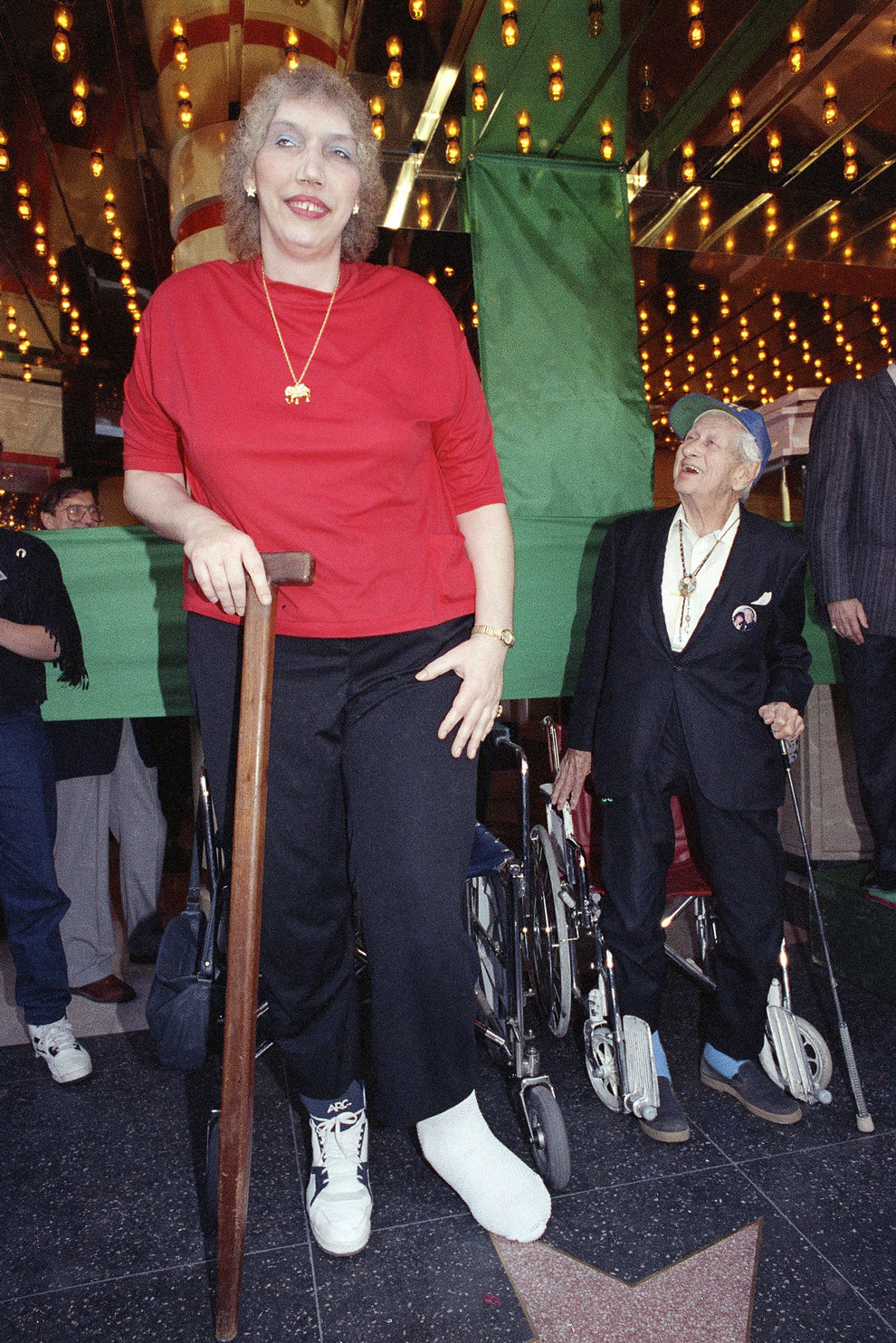
The Shelbyville graveyard where Sandy is buried is mostly empty the twilight I visit. Sycamores block the view of the factory on the edge of town. I walk what feels like the entire large cemetery’s paved paths before I find her grave. It’s at a far edge, separated by an unpaved path from all the others. Adjacent to a crumbling old barn and a chain-link fence, it is the loneliest grave. And where her specially constructed, extra-large casket was laid into the ground in four adjacent plots, they did not, it seems, attempt to replant the lawn as they have on the other graves; rather there is hard dirt, patches of weeds.
In other ways it is the most solitary grave, and the most beautiful. A group of her friends and admirers, who raised the funds for the gravestone after her death, purchased one of an unusual teardrop shape, upon which has been inscribed her name, and mine — Sandra E. Allen — and the phrase “Gentle Giant.” They also purchased a little white bench, so visitors could sit and face her, and the elementary school beyond the fence. Rita Rose tells me Michael once went to school there.
I’m struck by how perfectly her grave reflects her life: at once dilapidated, lonely; and yet unique, inviting, nearby to children. What are all those other little graves with their knickknacks compared to this one off here on its own.
I sit on the white bench. I look at the expanse of earth before me, trying to picture the enormous woman below. I say, “Hello.”
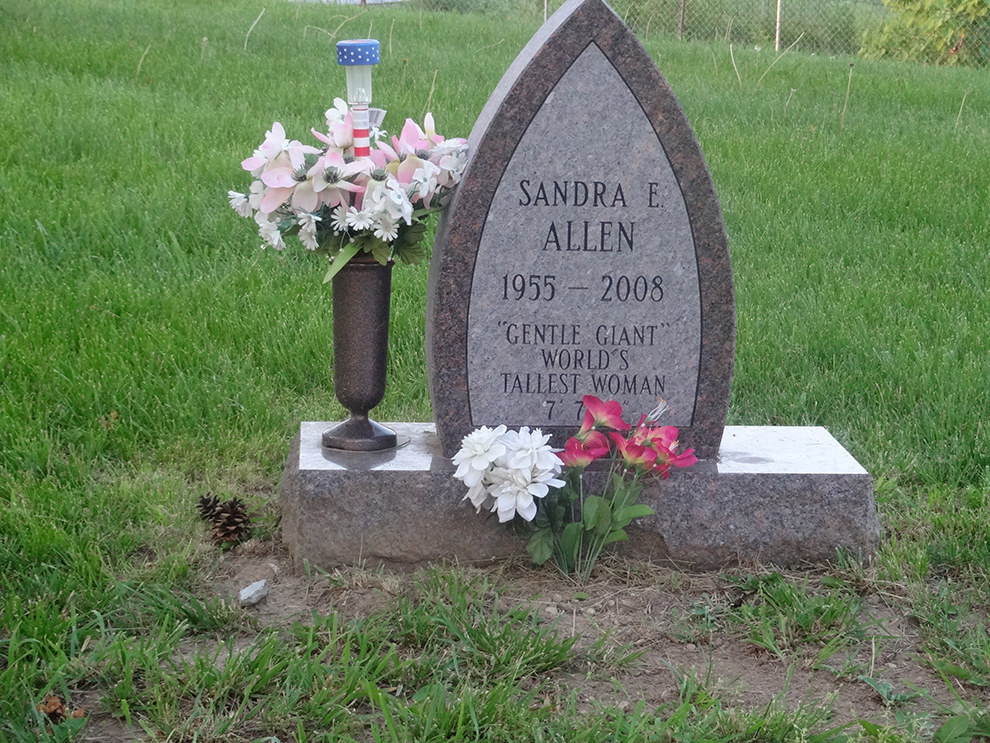
A previous version of this story misstated when Edna Parker died.
